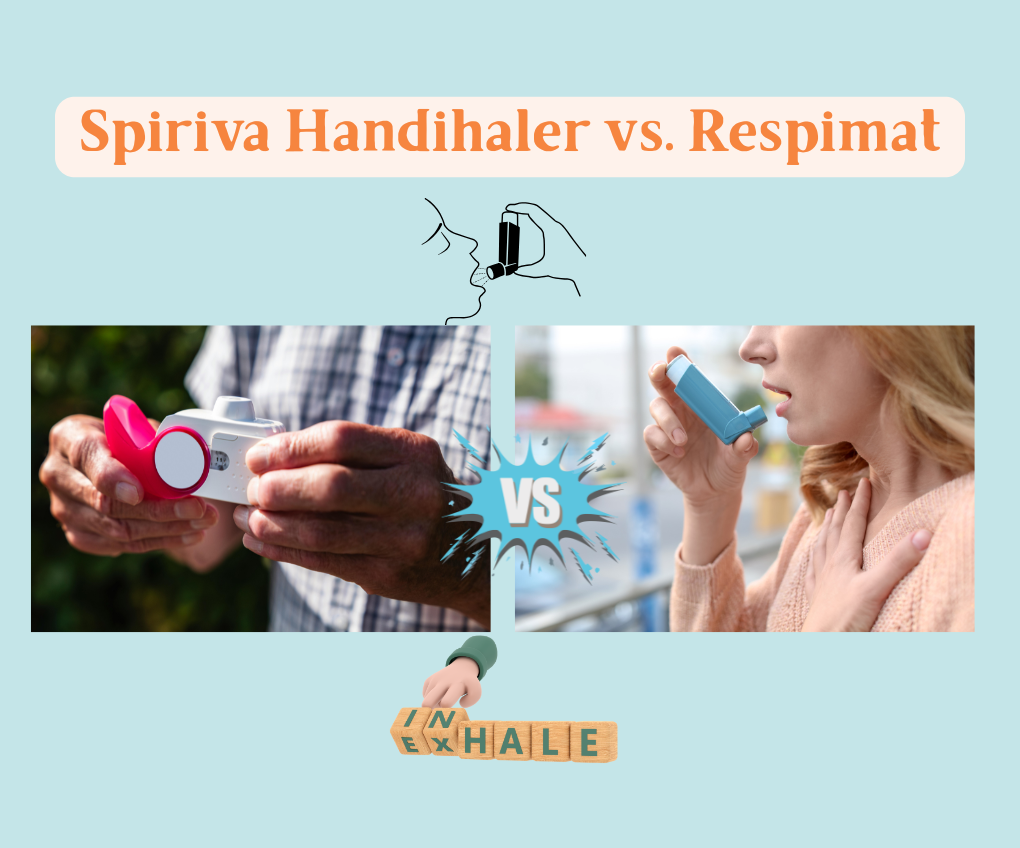When managing chronic obstructive pulmonary disease (COPD), choosing the right inhaler can make a significant difference in symptom control and quality of life. Tiotropium, a long-acting bronchodilator, is commonly prescribed for COPD and is available in two main delivery devices: the Spiriva HandiHaler and the Spiriva Respimat.
This guide compares the Spiriva HandiHaler vs Respimat for COPD, highlighting their key differences, advantages, and potential drawbacks. Whether you’re starting treatment or considering a switch, understanding the pros and cons of Spiriva HandiHaler vs Respimat can help you and your healthcare provider make an informed choice.
What is Spiriva and How Does It Work?
Spiriva is a prescription medication containing tiotropium bromide, a long-acting anticholinergic bronchodilator used to manage respiratory conditions like COPD and asthma. It works by relaxing the airway muscles, helping to open the airways and make breathing easier. Spiriva is available in two forms: the HandiHaler, a dry powder inhaler, and the Respimat, a soft mist inhaler.
Spiriva Respimat for asthma has been approved for maintenance treatment in patients aged 6 years and older, offering consistent lung function improvement and symptom control.
The Respimat version delivers medication as a fine mist, which may be easier for some users to inhale deeply, especially those with coordination issues. In contrast, the HandiHaler requires a deep, forceful inhalation to draw in the dry powder.
Overview Of Spiriva HandiHaler
Spiriva HandiHaler is a dry powder inhaler designed to deliver tiotropium bromide, a long-acting bronchodilator used primarily for the maintenance treatment of COPD. It comes with capsules placed in the device and punctured before inhalation.
This inhaler is breath-activated, which means it requires a certain level of inspiratory effort, making it less ideal for patients with severe breathing difficulty or poor hand-lung coordination.
When evaluating Spiriva HandiHaler vs Respimat, it’s important to consider that the HandiHaler may be better suited for patients who prefer or are accustomed to dry powder inhalers, while others may find the soft mist of the Respimat easier to use.
How the Spiriva Handihaler Works?
The Spiriva HandiHaler is a dry powder inhaler that delivers tiotropium bromide, a long-acting bronchodilator used to relax the airway muscles in patients with COPD. Each dose comes in a capsule that must be inserted into the device. Once pierced by the HandiHaler, the powder is released and inhaled deeply through the mouthpiece.
The medication blocks muscarinic receptors in the lungs, helping to open the airways for up to 24 hours. For the best outcomes, use once daily at the same time.
When comparing Spiriva HandiHaler vs Respimat, the HandiHaler requires a stronger, more forceful inhalation to draw the powder into the lungs, which may be challenging for some patients. In contrast, the Respimat delivers a slow-moving mist, which can be easier to inhale for those with limited lung function.
Pros and Cons Of Spiriva Handihaler
Pros:
- Time-tested and widely used with reliable dosing
- No need for coordination between actuation and inhalation
- The inhaler can be reused; only the capsules need to be refilled
- Lower cost compared to some alternatives
Cons:
- Requires strong, forceful inhalation to activate the powder
- Multiple steps are involved in preparing each dose
- Not ideal for those with reduced hand strength or severe airflow limitation
Who Might Prefer the Spiriva HandiHaler?
Patients comfortable with dry powder inhalers and those who can generate sufficient inhalation force may prefer the HandiHaler. In the comparison of Spiriva HandiHaler vs Respimat, the HandiHaler suits users who value simplicity and don’t struggle with the inhalation strength required for powder-based delivery.
Spiriva HandiHaler vs Respimat: Key Differences
When choosing between tiotropium inhalers, understanding the difference between Spiriva inhalers is essential for effective COPD or asthma management.
- Device Type: HandiHaler is a dry powder inhaler; Respimat is a soft mist inhaler.
- Inhalation Technique: HandiHaler requires a deep, forceful breath; Respimat uses a slow mist that’s easier to inhale.
- Dose Delivery: HandiHaler uses capsules; Respimat is preloaded and simpler to use.
- Onset of Action: Respimat may offer slightly better lung deposition and symptom relief due to its fine mist.
So, which Spiriva inhaler is better? It depends on the individual’s needs and capabilities. In the debate of Spiriva HandiHaler vs Respimat, those who struggle with deep inhalation may prefer Respimat, while others might favor the familiarity and simplicity of the HandiHaler.
Delivery Method
The delivery method is a major distinction in the comparison of Spiriva HandiHaler vs Respimat, and it plays a crucial role in how effectively the medication reaches your lungs.
- Spiriva HandiHaler uses a dry powder inhaler (DPI). It involves inserting a capsule into the device, piercing it, and inhaling the powder with a quick, deep breath. This method relies heavily on the patient’s inhalation strength to draw the medication into the lungs.
- Spiriva Respimat is a soft mist inhaler (SMI). It releases a slow-moving mist of medication, which doesn’t require a forceful breath. The fine mist remains suspended longer, allowing for easier and more consistent lung delivery, especially for patients with poor inspiratory effort.
When evaluating the difference between Spiriva inhalers, the delivery method can help determine which Spiriva inhaler is better for a particular individual, especially based on their breathing ability and comfort with using the device.
Ease of Use
Ease of use is a key factor when choosing between Spiriva HandiHaler vs Respimat, especially for older adults or those with coordination challenges. Spiriva HandiHaler requires several steps: opening the device, inserting and piercing a capsule, and taking a deep, forceful inhalation. Spiriva Respimat, on the other hand, is a preloaded device that delivers a slow-moving mist with the press of a button and a gentle breath in.
Dosing and Administration
The Spiriva HandiHaler is taken once daily using a capsule that must be loaded into the device before each use, requiring two inhalations per capsule to ensure full dose delivery. In contrast, the Spiriva Respimat is also used once daily but comes as a preloaded inhaler that delivers two puffs from the soft mist inhaler—no capsule handling needed. When comparing Spiriva HandiHaler vs Respimat, Respimat offers a simpler and more convenient dosing experience.
Suitability for Elderly or Weak Inhalation Strength
For the elderly or those with weak inhalation strength, the Spiriva Respimat is generally more suitable. The Spiriva HandiHaler requires a deep, forceful breath to inhale the dry powder, which can be challenging for those with weakened inhalation strength. Therefore, when comparing Spiriva HandiHaler vs Respimat, the Respimat is typically the preferred option for patients with compromised inhalation ability.
How to Choose the Right Spiriva Inhaler for You
Choosing the right Spiriva inhaler depends on various factors, including your inhalation ability, convenience preferences, and specific health needs. If you’re wondering how to use Spiriva HandiHaler, it requires placing a capsule in the device, piercing it, and taking a deep, forceful breath. This method works well for individuals who have strong inhalation abilities and are comfortable with dry powder inhalers.
FAQs
Is Spiriva Handihaler the same as Spiriva Respimat?
No, Spiriva HandiHaler and Spiriva Respimat are not the same with each other. Both contain the same active ingredient, tiotropium, but they differ in delivery methods. HandiHaler is a dry powder inhaler that requires a deep inhalation, while Respimat is a soft mist inhaler that delivers a fine mist, making it easier to inhale. The choice between the two depends on individual preferences and inhalation abilities.
Which Spiriva inhaler is easier to use?
The Spiriva Respimat is generally easier to use, as it delivers a soft mist that requires less forceful inhalation compared to the Spiriva HandiHaler. With the Respimat, you simply press a button and inhale gently, making it more suitable for those with weak inhalation strength or coordination issues. This makes Respimat the preferred option for many patients seeking convenience and ease of use.
Can Spiriva Respimat be used for asthma?
Yes, Spiriva Respimat is approved for the maintenance treatment of asthma in patients aged 6 years and older. The U.S. Food and Drug Administration (FDA) authorized its use based on clinical trials demonstrating its efficacy and safety in improving lung function.
Is one Spiriva Handihaler more effective than the other?
Both Spiriva HandiHaler devices deliver the same active ingredient, tiotropium bromide, and are equally effective when used correctly. The key factor is proper usage, as both versions are designed to provide the same dose of medication.
How often should Spiriva Handihaler or Respimat be taken?
Both Spiriva HandiHaler and Spiriva Respimat should be used once daily for the maintenance treatment of COPD or asthma. For the HandiHaler, one capsule is used per day, with two inhalations per capsule. For the Respimat, it is typically two puffs (1.25 µg each) once a day. To be very careful while using the dosage and frequency, and it’s important to follow your healthcare provider’s instructions.
Can I switch from Spiriva Handihaler to Respimat?
Yes, you can switch from Spiriva HandiHaler to Respimat, but make sure before taking any step first consult your healthcare provider. Both devices deliver the same active ingredient, tiotropium, but the delivery methods differ.
Does Spiriva Respimat require priming before use?
Yes, Spiriva Respimat requires priming before its first use and if it hasn’t been used for more than 3 days. To prime the inhaler, hold it upright, turn the base in the direction of the arrows until it clicks, then flip open the cap and press the dose-release button until you see a spray. Repeat this until a visible spray is produced. If the inhaler has been unused for 21 days, you will need to prime it with 4 sprays before use.


